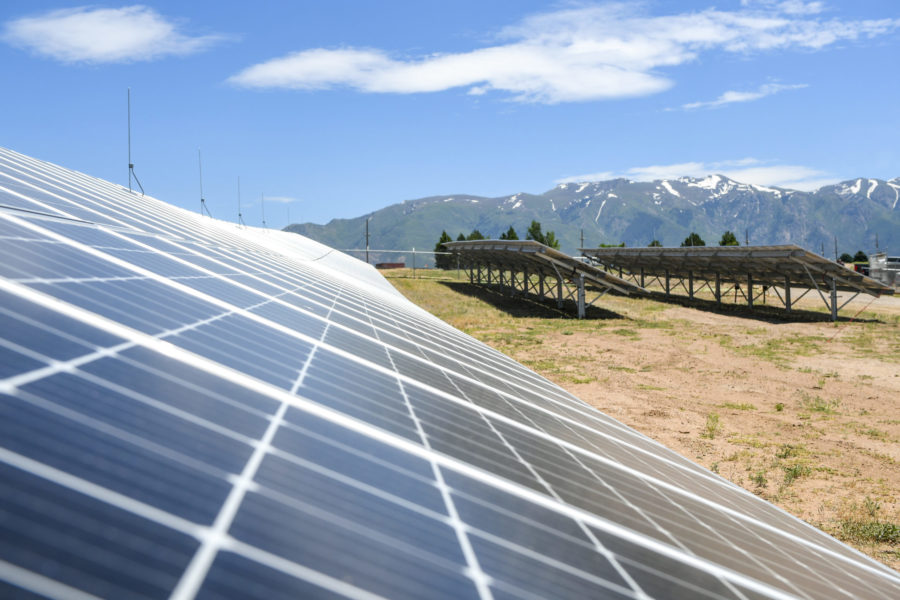The Department of the Air Force is aiming to slash emissions across its installations, non-tactical vehicles, and aircraft fleets in the coming years. It intends to aggressively pursue new forms of sustainable energy and to factor climate change into its wargames, operations, and acquisitions, according to a new action plan released Oct. 4.
The DAF’s Climate Action Plan, signed by Air Force Secretary Frank Kendall, lays out three priorities for the department when it comes to climate change:
- Maintain air and space dominance in the face of climate risks.
- Make climate-informed decisions.
- Optimize energy use and pursue alternative energy sources.
In pursuit of those priorities, the 24-page document identifies six objectives for the DAF to pursue, broken down into 20 “key results” describing the department’s “future state.”
“We must prioritize air and space dominance in a security environment shaped by a changing climate, yet also recognize and reduce the department’s role in contributing to climate change,” Kendall wrote in a letter included in the action plan. “Department capabilities that provide air and space dominance and global reach are fed by a steady diet of fossil fuel, representing the bulk of the Defense Department’s carbon footprint and a continual burden on our changing climate. We will, therefore, demand increased efficiency in our warfighting systems and installations as well as strive to reduce our impact on the environment, all while enhancing our warfighting capabilities.”
Some of the most ambitious key results the Air Force and Space Force are pursuing relate to the infrastructure and logistical enterprise behind the services’ warfighting capabilities.
For example, the action plan calls for the department to reach net-zero emissions across its installations portfolio by fiscal 2046, just over two decades from now. More immediately, the department wants to cut emissions from 2008 levels in half by fiscal 2033.
To reach such a goal will require the Air Force to upgrade and modernize facilities, something the service has already started to do in places where extreme weather events are becoming increasingly common. Tyndall Air Force Base, Fla., has emerged as the model for the “Installation of the Future” after being devastated by Hurricane Michael in 2018.
The Climate Action Plan calls for increasing resiliency and energy efficiency across all bases with added investments over the next several years, reaching $100 million by fiscal 2027. It also calls for every installation to complete an assessment for its risks due to climate change—some have already begun—and to incorporate the results of those assessments into their master development plans and installation energy plans, if needed.
Such plans are “focused upon resiliency measures for installations around five key areas: robustness, resourcefulness, redundancy, response, and recovery,” Edwin Oshiba, the acting assistant secretary of the Air Force for energy, installations, and the environment, told lawmakers in March.
Getting to net-zero emissions will also involve identifying alternative forms of energy, something the action plan addresses as well. By fiscal 2030, the department is aiming for all its electricity to be carbon pollution-free, which would include “marine energy, solar, wind, hydrokinetic, geo-thermal, hydroelectric, nuclear, renewably sourced hydrogen, and electrical energy generation from fossil resources to the extent there is active capture and storage of carbon dioxide emissions,” according to the action plan. Half of that electricity would be produced within the same regional grid where the energy is consumed.
The department is also hoping for all of its non-tactical vehicles—everything from cars and buses to aircraft support equipment—to be zero emission by fiscal 2035. The action plan states that effort is already underway, largely through electric vehicles.
But while alternative forms of energy can reduce emissions from bases and ground equipment, the Air Force still has one major source that may be harder to tackle—the planes Airmen fly in every single day.
The Defense Department is one of the world’s largest consumers of fossil fuels, and the Air Force is the department’s biggest customer on that front, with jet propellant accounting for the majority of that bill.
The Air Force has experimented with alternative fuels for years now, and the Climate Action Plan calls for those experiments to progress to a test program by fiscal 2026 in which two operational USAF locations have 10 percent of their aviation fuel come from sustainable fuel blends that cost the same as or less than traditional fuel.
The project “will validate operational, infrastructure, and logistical requirements for blending and quality control in the use of sustainable aviation fuel,” the goal states.
On top of that, the action plan also calls for the department to make the traditional fuels it does use go further by increasing operational energy efficiency by 5 percent by fiscal 2027 and 7.5 percent by 2032 “through standardized use of aircraft drag reduction technologies, modern software scheduling tools, and enhanced engine sustainment practices.”
Work on drag reduction techniques and technologies has primarily focused on the mobility and refueling fleets, Oshiba said in March—“things like micro-veins and winglets that allow us to extend the range of our assets that provides operational reach with fewer assets.”
The service is also looking to develop a prototype of a blended-wing body aircraft, which would provide large internal volume and aerodynamic efficiency. The Defense Innovation Unit issued a solicitation in July for design concepts for a blended wing body tanker aircraft.
When it comes to operations, the action plan also calls for the department to do more to educate Airmen and Guardians on the effects of climate change and to consider its impacts on everything from acquisition requirements to wargaming.

